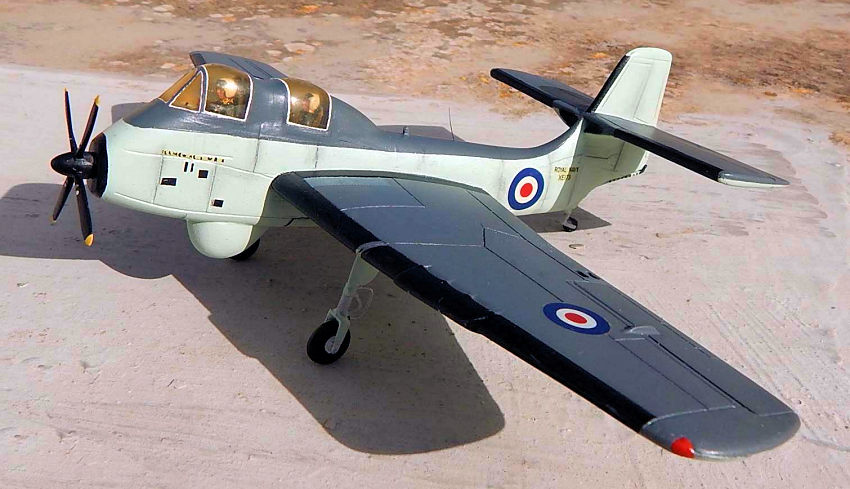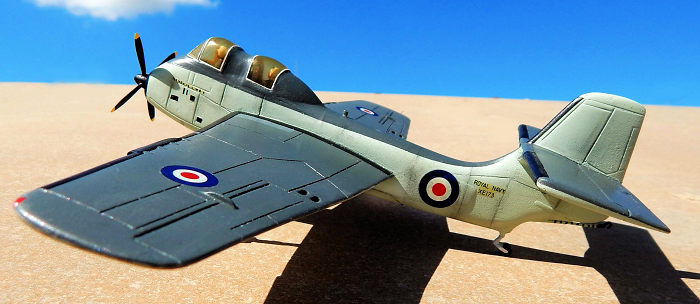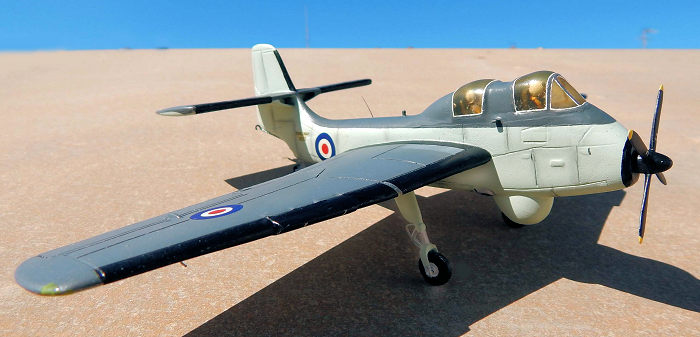
Contrail 1/72 Short Seamew
| KIT #: | |
| PRICE: | $ |
| DECALS: | Two options |
| REVIEWER: | Carmel J. Attard |
| NOTES: | Vacuform with injected plastic and metal parts. |

| HISTORY |
An order was placed in February 1955 for 60
aircraft (split evenly between the FAA and RAF). with Seamew
XA213 successfully completing
carrier trials on HMS Bulwark
in July and December 1955. Naval service flight trials with two Seamews were
carried out with 700 Naval Air Squadron in November 1956, which included
catapult trials and around 2 00 takeoffs and landings on HMS
Warrior.
00 takeoffs and landings on HMS
Warrior.
The RAF lost interest after four Mk 2s were built with three of them converted to AS1 standard; the fourth (XE175) was flown by S/L W. "Wally" J. Runciman for a series of sales tours in 1956 to Italy (March), Yugoslavia (April) and West Germany (May).
Meanwhile the FAA decided that the RNVR Avengers would be replaced by Seamews, but only four had been taken on charge by the time the RNVR squadrons were disbanded in March 1957 in keeping with the 1957 Defence White Paper, before any Seamews were allocated to them. Seven aircraft eventually delivered to the FAA were scrapped at RNAS Lossiemouth, and the other 11, complete and awaiting delivery, were scrapped at Sydenham. The Seamew was found to have poor handling characteristics and was underpowered. About the same size as the Gannet but it was powered by a single, as opposed to double, Armstrong Siddeley Mamba turboprop.
The last surviving Seamew, XE180 which had been purchased by Shorts on 31 August 1959 for ground instruction at its Apprentice Training School, was scrapped in 1967.The Rolls-Royce Heritage Trust has preserved a Seamew engine, which is found at its Coventry branch.
| THE KIT |
 It is difficult to call the Seamew beautiful, but it has a distinctive and
interesting shape, and the Contrail kit was very welcome. The vacform kit comes
in a stout cardboard box with instructions, photographs, scale plans and two
decal options. Moulded in white plastic card that contains all components on it.
Also included in a sealed bag is an injection moulded undercarriage legs, wheels
and an arrestor hook. The propeller is made of white metal. Pilot and observerís
cockpit canopies are also provided in clear vac form acetate which turned pale
orange with time.
It is difficult to call the Seamew beautiful, but it has a distinctive and
interesting shape, and the Contrail kit was very welcome. The vacform kit comes
in a stout cardboard box with instructions, photographs, scale plans and two
decal options. Moulded in white plastic card that contains all components on it.
Also included in a sealed bag is an injection moulded undercarriage legs, wheels
and an arrestor hook. The propeller is made of white metal. Pilot and observerís
cockpit canopies are also provided in clear vac form acetate which turned pale
orange with time.
| CONSTRUCTION |
The main components are generally accurate and I used the scale plans provided to measure the fuselage width, overall span dimensions and overall length. I have done away with the tail wheel undercarriage as it appeared oversize and the main undercarriage legs needed some refinement and reshaping.
 Otherwise I used the kit parts throughout and can be said the model was built
straight from the box employing generally the usual techniques in building a
vacform kit but using extra care. Principal extra additions includes mainly
detailing the sparse cockpit office, adding instruments with adequate reference
as well as 2 crew figures. The two canopies were trimmed and made to conform to
the place where they had to be attached to the fuselage. Fuselage area around
cockpit required to be sturdy enough in order to support the wings, adding more
internal bulkheads and also inserting a supporting prop made out of plastic
sprue which would hold the main planes level and aligned when these are fixed to
the fuselage. The fuselage jet exhaust was also replaced with a hollow tubing
that was cut to measure and blanked on the inside within the fuselage .
Otherwise I used the kit parts throughout and can be said the model was built
straight from the box employing generally the usual techniques in building a
vacform kit but using extra care. Principal extra additions includes mainly
detailing the sparse cockpit office, adding instruments with adequate reference
as well as 2 crew figures. The two canopies were trimmed and made to conform to
the place where they had to be attached to the fuselage. Fuselage area around
cockpit required to be sturdy enough in order to support the wings, adding more
internal bulkheads and also inserting a supporting prop made out of plastic
sprue which would hold the main planes level and aligned when these are fixed to
the fuselage. The fuselage jet exhaust was also replaced with a hollow tubing
that was cut to measure and blanked on the inside within the fuselage .
The wings and tailplanes went together fairly easily adding cross section
brackets at intervals within the wings interior to make them strong enough and
retain shape. The leading edge slots were nicely produced in the kit. I
strengthened the wings by inserting long piece of sprue and that made them
retain the required thickness,. The outer wing panels had dihedral and so care
was taken when rubbing do wn the lower half.. The yokes and main wheels had to be
drilled out to take wire axles.
wn the lower half.. The yokes and main wheels had to be
drilled out to take wire axles.
The last component to be added to the kit was the white metal propeller. This needed light rubbing down with wet and dry paper before it was painted black with yellow tips. Many of the panel lines needed to be rescribed as the sanding almost removed a number of them. A tail wheel leg was added as this was not supplied.
There were two decal options: An RAF Coastal Command aircraft in overall dark sea grey and a Fleet Air Arm example in sky and extra dark sea grey which I chose to do. Model was sprayed using Humbrol paint. The black de-icing boots were brush painted. Dark grey decal was used for wing walk-way areas. In spite of age on the kit, the decals behaved very well and adhered without any difficulty.
| CONCLUSIONS |
I highly recommend the kit if you can get hold of one and any vac form builder with average experience can produce highly satisfactory results. I am thankful to Richard Stracey of Brisbane who kindly provided the kit for this build.
24 April 2017
Copyright ModeingMadness.com
If you would like your product reviewed fairly and fairly quickly, please contact the editor or see other details in the Note to Contributors.
Back to the Main Page Back to the Review Index Page Back to the Previews Index Page